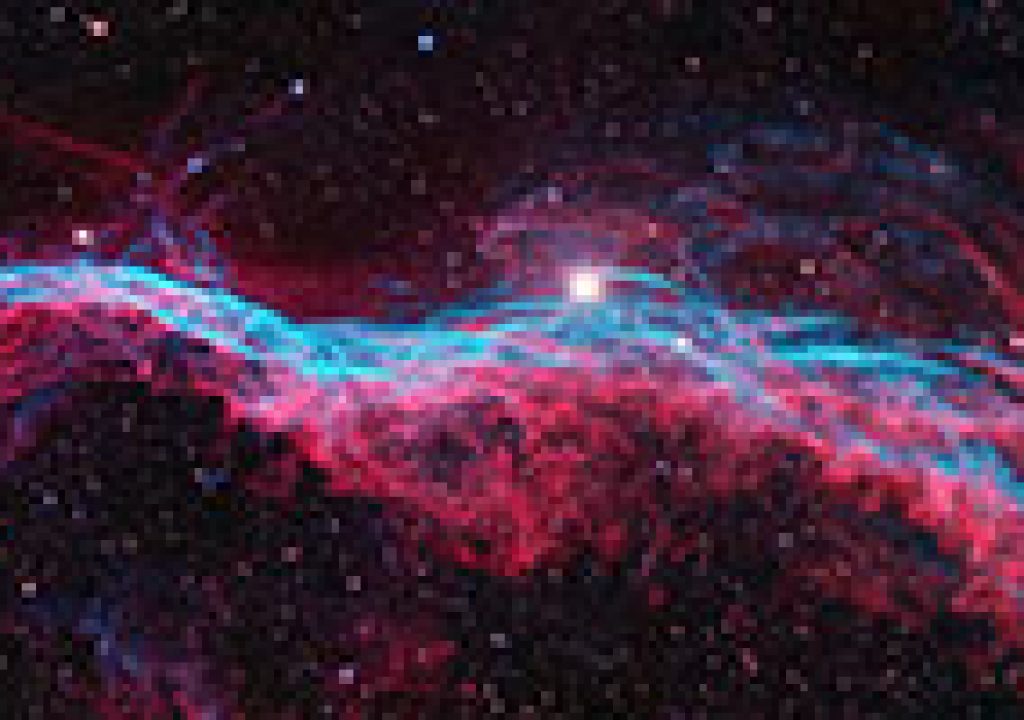Nebulas can be created several ways in After Effects: with “cards in space” of real images, or generated by Fractal Noise or 3D particle systems, commonly fractal-displaced particle arrays like Trapcode Mir, Form, Hitfilm Atomic Particle, and other particle systems.
Nebulas can be created several ways in After Effects: with “cards in space” of real images, or generated by Fractal Noise or 3D particle systems, commonly fractal-displaced particle arrays like Trapcode Mir, Form, Hitfilm Atomic Particle, and other particle systems.
Peder Norrby of Trapcode recently released a free Nebula Construction Kit (a video guide to an AE project file), with nebulas created in Trapcode Mir and stars created in Form (which could be done with AE’s Particle World, or other). There are custom sliders to control the most important properties, so adjusting one of the sample comps looks easy.
Also for Mir users, Jeremy Cox posted a nebula render last year. Here’s the video, as well as hints on replicating it:
Steps toward a whispy nebula with Trapcode Mir
(reposition & resize mesh, increase clarity and rez, adjust fractal displacement)
• In Geometry, reposition the Mir mesh near the center of the screen, and increase Size X,Y (~1500).
• In Material, reduce opacity to <10 until mesh background disappears (add glow and tonal correct later).
• In Geometry, increase the number of Vertices X,Y (~800), then rotate Y so you see more of the mesh.
• In Fractal, to taste, increase amplitude (~300), decrease frequency (~60), increase complexity (~10) and amplitude X,Y; then increase FBend X,Y a notch or 2 to warp.
• Add dust cloud/particles and Glow, add color correction (Mir also has Texture Layer for color), and starfield background to taste.
• Animate Mir mesh or a Camera.
A nebula is a great cloud of plasma, gas, and dust in space, but also, a now archaic term for galaxy. Nebulas can look like puffy clouds (the Monkey Head Nebula) or like whisps of fractal noise (the Veil Nebula). Images of nebulae are composites of grayscale layers from data captured of different filters and wavelengths of light, and there’s plenty of room for tasteful artistic interpretation.
And because this stuff is interesting, here’s a slick render, Celestial Snow Angel: Star-forming Region Sharpless 2-106. To go deeper into Hubble image creation, see Creating Hubble’s Technicolor Universe (PDF) by STScI’s Ray Villard and Zoltan Levay from Sky & Telescope. There’s more on the entire venture, with some imagery, in Hubble 3D, an Imax movie that’s also on Blu-ray. Later, CNET posted more video from updated data sets of the Eagle Nebula in Here’s what the Pillars of Creation look like in three dimensions.
An easy way to create nebulas would be using 2.5D cards in space with real images, creating layers with procedural extraction or the raw Hubble image layers in Photoshop. Alternatively, and untested here, displacement techniques usually used to create 3D animation from 2D faces should work too; see for example, Vale Productions on how to Bring 2D to life using Displacement Maps, and Tara Arts Movie on How to Make 2d Image to 3D using Displacement Map (After Effects & Photoshop).
Additional options include Fractal Noise / Turbulent Noise effect layers (resource roundup), adding 3D effects or images of dust (more cloud than dust at a distance), glows, stars (particle field or Deep Star Maps), and color overlays. However useful, no 3rd-party plug-ins are required. Stacked layers might be needed, akin to old pseudo-3D text, so check out Pseudo-volumetric fractal clouds in After Effects.
The Hitfilm team has a good example of a barebones approach in Create a 3D space nebula, which uses HubbleSite space images and 3D particle dust to create an effective scene. You could mimic the setup in After Effects with native effects, though using Hitfilm plug-ins might be easier.
Also from Peder Norrby is Inside the Nebulae – tutorial and AE project, which is based on actual images of nebulae combined in After Effects with CG gas clouds and stars made using Trapcode Form and Starglow. Harry Frank’s refresher on Trapcode fractal fields might be useful too.
Create a Surreal Particle Nebula by Dobromir Dyankov uses Trapcode Particular to create a certain look.
VinhSon Nguyen has several space-oriented tutorials, including these near-nebula pieces, Nebula Galaxy With Trapcode Form and Galaxy Nebula with Trapcode Particular Tutorial. Since we’re referring to nebula in its archaic meaning, here’s also Galaxy After Effects tutorial from Nagesh Kandel via Sharelog, which uses Trapcode Particular in After Effects. Here’s samples:
Later Motion Squared posted Trapcode Form Galaxy Tutorial. It focuses on workflow, but project files are available too.
The Fractal Noise 3D plug-in from CROSSPHERE .Koizumi, which reacts to After Effects comp cameras and lights, also seems like it would be useful, especially if you need volumetric depth. See also Pseudo-volumetric fractal clouds in After Effects.
No doubt there’s something to learn from Andrew Kramer’s intro to the Star Trek: Into Darkness titles; it used a single camera flying around space through nebulas and galaxies. And recent tutorials like Solar Atmosphere and Seamless Spherical Maps should get the fractal noise juices flowing.
Also, there’s Spacescape by Alex Peterson, an Open Source tool for Windows (the Mac OS version never came) that creates space skyboxes with stars and nebulas. It seems like a nice idea for an After Effects filter.
Maya / AE users might be interested in volumetric nebula solutions dicussed in The Nebula Challenge at The Fulldome Blog of the Charles Hayden Planetarium in Boston.

